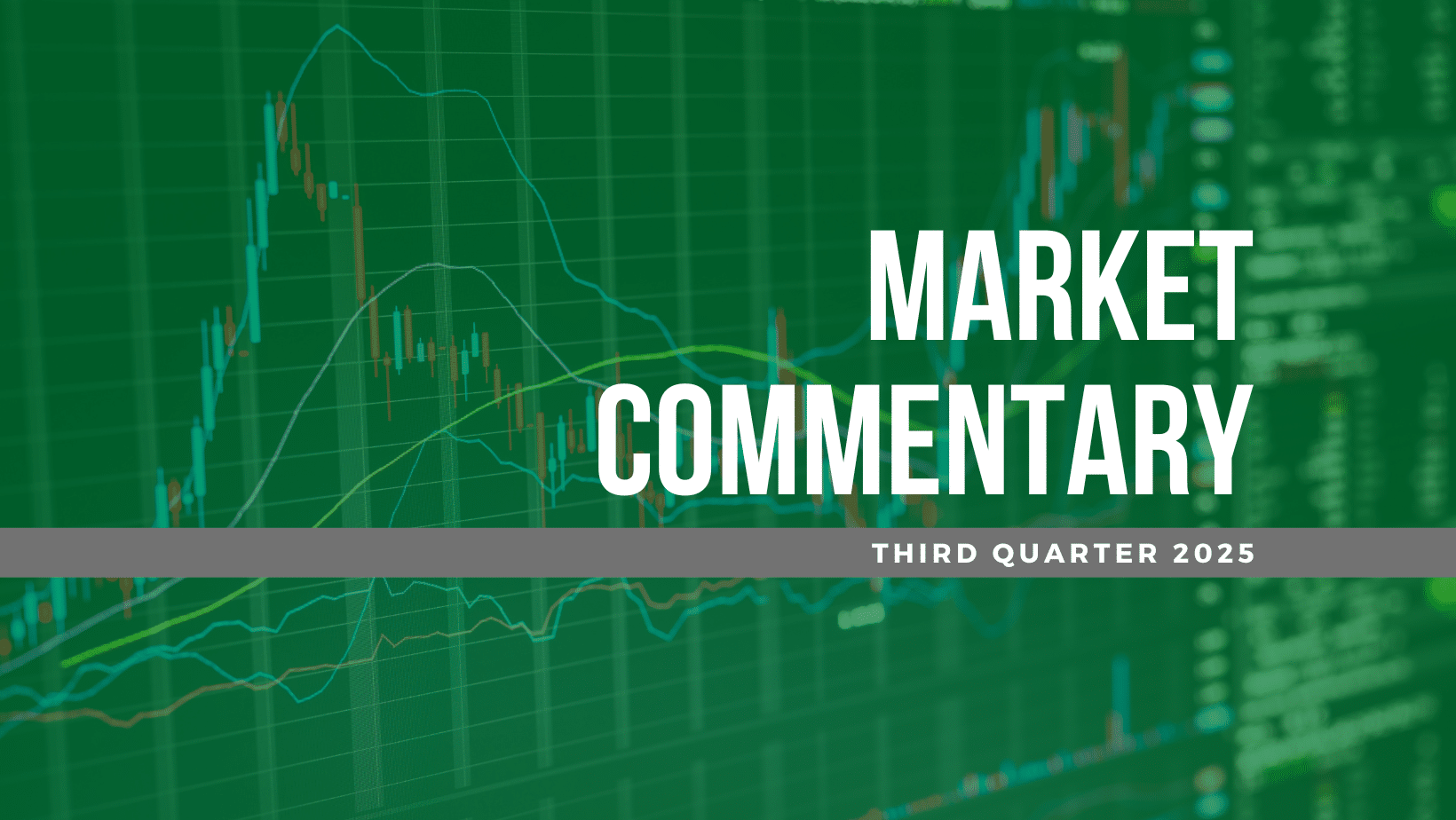July 3, 2025
Economic Overview
By Dr. Mark Pyles
Ideally, economic data serves to define the foundation on which financial markets perform. The US economy has never been more complex. With ever increasing technological advances, massively intricate global trade gyrations, an increasingly polarized political backdrop, and a consuming body always ready to push the envelope in pursuing new ideas and processes, what has always been very difficult to capture has become increasingly more so. Economies typically go in cycles and financial markets anticipate, react to, and pivot around the phases of these cycles. All of this is a natural dance between economic conditions and financial market reactions. However, a critical element of the relationship is reasonably accurate data on which to base assertions regarding the state of the economy.

Dr. Mark K. Pyles
Director of Multi-Asset Strategies
We have learned through Q3 of 2025 to be careful about assuming and extrapolating economic data in the current environment. We came into the quarter with the consensus belief that two legs of the economic stool – inflation and growth – were trending moderately in the wrong direction. The predictable spillover of the well-debated tariffs was just starting to drive inflationary pressures and cast headwinds on economic growth. However, we were comforted by the third leg of the stool – a steady labor market that would support consumer spending and fend off meaningful economic downturn. In the previous quarter’s economic commentary, we pointed out the resilient strength of the job market through data available.
However, since that writing, the July payroll report released by the Bureau of Labor Statistics revised the prior two months down by over 250,000 jobs. Further, a few weeks later, annual benchmark revision to payrolls erased over 900,000 jobs from April 2024 through March of 2025. These revisions, along with a significant downward surprise from the August report have served to stoke fears of a labor market that was much softer than previously believed. There are a variety of difficulties in capturing accurate data in the current US labor market, including very low survey response rates, challenges in truing-up seasonality measures following the singular disruption of COVID, and new notions of what labor means (e.g., the gig economy, content creators, single owner business creation, and secondary jobs).
To somewhat mitigate the bumpiness of payroll data, we can review the three-month moving average of nonfarm payroll additions. In January of this year, that number stood at over 230,000 jobs. The average from January 2022 through December of 2024 was 187,000 jobs. Today, after all the downward revisions, that number stands under 30,000. In addition, the number of job openings, as measured by the JOLTS survey, decreased from a peak of over 12 million in early 2022 (or two jobs for every one unemployed person at the time) down to just over 7 million today (or less than one job per unemployed person).
Despite the negative trends detailed in the preceding discussion, the unemployment rate has remained relatively contained at 4.3% currently. This is due in significant part to a decrease in labor supply somewhat offsetting a decrease in labor demand. Further, to be fair, we also do not yet see evidence of systematic firings or layoffs in the workforce, as weekly jobless claims continue to remain below 250,000. As such, it currently appears to be a “slow to hire, slow to fire” job market as many employers await more clarity on the economic outlook, tariff ramifications, and regulatory issues before making meaningful changes to their employment roster.
The Federal Reserve Open Market Committee (FOMC) has taken note as well. Just days prior to the July employment report, the Committee chose to maintain rates at the then current level. At that point, the conveyed belief was that while their dual mandate of price controls and a full-employment labor market were divergent, the risk of higher prices was greater than that of a softening labor market. In hindsight, it is likely the decision on rates would have been different had the meeting been held one week later. In August, during his annual Jackson Hole speech, Powell strongly implied a rate cut was the next likely step, and the committee solidified this through a 25BP cut on September 17th to bring the Fed Funds rate down to a range of 4.00% – 4.25%.
The tone of the statement and press conference also validated the belief that the recent revisions of job market data elevated that concern above that of higher inflation levels. In regard to inflation, there is good news and bad news. The bad news is that the direction of travel remains the opposite of desired. Headline CPI has increased on a year-over-year (YoY) basis for four straight months, from 2.3% in April to 2.9% in August. Core PCE, the Fed’s preferred metric, has similarly increased from 2.6% YoY in April to 2.9% in August. However, the good news is that price levels are increasing by less than was feared earlier in the summer. Further, there is logical reason to believe that much of the tariff-related pricing pressures will be transitory and should begin to dissipate as we turn into the new year and beyond. This belief appears consistent with the Fed’s collective thought as they penciled in two additional cuts for this year and another two for 2026.
Of course, at the end of the day, it is always helpful to remember that we are a consumer-led economy. Over two-thirds of GDP comes from personal consumption, and it is a well-known adage to never bet against the American consumer. Calculating economic growth for the current year has been very cloudy due to the trade influences from the new tariff regime. The recent final estimate of Q2 Real GDP growth was revised significantly upward, to 3.8%, led by 2.5% QoQ annualized personal consumption. While this latter metric still represents a slowdown from 2024, where the four quarters averaged 3.4%, it does not indicate that the consumer is wilting under somewhat higher prices.
It is worth noting one particularly negative area of the economy. Housing has remained constrained due to a combination of higher rates, sticky housing prices, and an uncertain economic backdrop. The average 30-year mortgage rate according to bankrate.com has averaged over 7% since the beginning of 2023, compared to under 4% for the 2015-2019 period pre-COVID. At the same time, starting in March of 2023, according to S&P Cotality Case-Schiller, housing prices increased on a month-over-month basis for 24 straight months. As a glimmer of hope, however, very recent data suggests the tide may be turning. Average mortgage rates are now below 6.5% for the first time since early 2023, and prices are also starting to mildly moderate with five straight months of negative MoM moves. The hopeful expectation is that this combination will serve to unlock activity.
Ultimately, we are again left with the confusing mosaic of incoming data that largely puts the economy somewhere in the area of “okay.” We all received a meaningful reminder this quarter to not get too attached to any singular data point or series. Betting odds for a recession this year have nearly priced out the possibility, and most market participants see catalysts from the One Big Beautiful Bill (OBBB) starting to meaningfully flow through in the new year. While we recognize the uncertainty surrounding the state of the labor market, we remain confident in the American consumer and feel the economy can continue to grow. As such, our base case is that we remain in a slowing, but stable, economy – one on which financial markets can continue to operate efficiently and effectively.
The Stock Market
By Walter B. Todd, III
“Two thousand, zero, zero, party over, oops, out of time. So tonight, we’re going to party like it’s 1999.” Prince’s hit song, 1999, was actually released in 1982. I was 11 and I remember hearing the song and thinking – 1999, that’s so far away. I’ll be so old when we get there. Well, here we are 43 years from the song’s release and 26 years from the title year. I know what you’re thinking – land the plane Walter. I hear you; I’m gliding it in.

Walter B. Todd, III
President, Chief Investment Officer
Of course, 1999 was also the year before the infamous “Internet Bubble” in the stock market started to burst after peaking in March 2000. My ancient, 28-year-old self had just graduated from business school in the spring of 1999 and was working for Lehman Brothers on Wall Street that fall. I had the good fortune to hear Warren Buffett speak while I was at Wharton in April 1999. That year, according to Fortune Magainze, Buffett made the following statement – “Once a bull market gets under way, and once you reach the point where everybody has made money no matter what system he or she followed, a crowd is attracted into the game that is responding not to interest rates and profits but simply to the fact that it seems a mistake to be out of stocks.” Now to be clear, I’m not necessarily saying that 2025 is the same as 1999, but I cannot think of more accurate description of the types of moves we have seen in certain areas of the market over the last 3 to 4 months than what Buffett describes above. I’ll pick back up on this topic at the end of this write-up, but for now let’s examine what happened in the latest quarter.
The S&P 500 picked up in the third quarter where it left off to end the second, moving steadily higher at nearly a 45-degree angle. A few small bumps to start August and September, but strong finish, closing out the quarter just below all-time highs and rising 8.1%, including dividends. This puts the index up 14.8% YTD. After a rough first half, small-cap stocks (as measured by the S&P 600) came to life, jumping +9.1% for the quarter and moving into positive territory YTD, up +4.2%. Performance outside the US slowed a touch in Developed International Markets, rising just +4.9% for the quarter (as measured by the EAFE Index) while Emerging Markets (EM) posted a stronger gain of +10.9% for the period (measured by the MSCI Emerging Market Index). EM benefited from significant bounce out of China. Year-to-date, these geographies are up +25.8% and +28.2%, respectively. Putting the US and International Markets together, the MSCI All-Country World Index (ACWI) finished higher by +7.7% for the quarter and is up +18.9% YTD.
From a sector perspective, 9 of 11 sectors were positive for the period while only 3 of 11 outperformed the broader market (S&P 500). Sector leadership completely turned back toward the 2023/2024 playbook, with the “big 3”, Technology (+13.2%), Communication Services (+12.0%) and Consumer Discretionary (9.5%) taking the top 3 spots. This led to predictable outperformance of the market-cap weighted index over the equal-weighted version (see performance table on page 4). On the opposite end, Consumer Staples (-2.4%), Real Estate (+2.6%) and Materials (+3.1%) brought up the rear for the period. In the middle, Utilities (+7.6%), Energy (+6.2%), Industrials (+4.9%), Healthcare (+3.8%) and Financials (3.2%) showed a mix of defensive and cyclical tendencies in the market. For the YTD period through September 30, 2025, all 11 sectors were in the green with 4 of 11 outperforming the broader market. Communication Services (+24.5%) and Technology (+22.3%) switch places from the quarterly ranking, while Industrials (+18.3%), Utilities (+17.7%) and Financials (+12.7%) round out the top 5. Utilities have benefited from strong power demand from AI. Consumer Discretionary (+5.3%), which performed well recently, drops into the bottom three for the YTD period, along with Consumer Staples (+3.9%) and Healthcare (2.6%). To start October, we saw some significant rotation into the laggards in Healthcare. We’ll see if that continues as we move through yearend.
Delving into the factors that drove market performance; they were similar to the second quarter, only stronger – Growth over Value, while Momentum and Volatility were also positive. Size played differently in different parts of the market. Size was in favor in the Large-cap space while it was out of favor in Small-cap. Investors seemed to be utilizing a barbell approach in going for the largest of the large and the smallest of the small. While again, not necessarily a favorable backdrop for our strategies, stock selection provided another strong tailwind to the absolute and relative performance in our Large-cap strategy. Our Small/Mid-cap portfolios enjoyed solid absolute performance but lost relatively due to positioning in slightly bigger, more profitable names (there was a “dash for trash” in this space). The Dividend & Income strategy lagged absolutely and relatively as Dividends as dividend stocks were out of favor and several large index holdings performed better than expected. Finally, our International ETF portfolio performed in-line with the positive returns outside the US.
Circling back to beginning, you likely hear in the business media that market volatility is low. That is technically true for the market overall as the VIX Index (volatility index) sits at 16 within a range of 13 to 60 over the past year and below an average of 19. However, individual name volatility is off the charts. As an example, you see Oracle (ORCL), an over $500 billion software company, jumping 40% in one day. On the downside, Marvell (MRVL), a $72 billion semiconductor company, dropping 20% in one day on some otherwise boring earnings news. This can create opportunities, such as selling some ORCL on the massive bounce or buying some MRVL on an overreaction to news (both of which we did). However, these types of market movements are extreme. Consider another example of a company, Oklo Inc. (OKLO), that now has a $17 billion market capitalization and $0 revenues, $0. Best Buy (BBY) has a similar market capitalization and over $41 billion in annual revenue. These are the types of situations that would make you crank up the Prince music. Many in the market today are trying to maximize returns. We believe this is a time to equally manage risk. We continue to look for the opportunities presented by individual name fluctuations but want to be cognizant of potential headwinds of high valuation and market players that may be partying a little too hard at the moment.
The Bond Market
By John D. Wiseman
Fixed income markets saw strong results capping the third straight quarter of positive returns and the best yearly performance to this point since 2020. Attitudes shifted from a global flight-to-safety trade amid heightened trade tensions earlier in the year to a cooling economic environment, thereby allowing the Federal Reserve to right-size their benchmark rate. The 10-Year Treasury Note finished the quarter with a yield of 4.15%, which is a modest 8 basis points (bps) lower on the quarter, but 42 bps below the level at the start of the year. This equates to total returns of 1.81% and 6.93%, respectively.

John D. Wiseman
Director of Fixed Income
The yield on the 2-Year Treasury Note was lower by 11 bps for the quarter to 3.61% producing a total return of 1.01%. This yield is sharply lower than the start of the year – down 63 basis points, which results in a total return of 3.72%. The Federal Reserve lowered its rate by 25 bps in September to the 4.00% to 4.25% range and is expected to continue to bring this down. This influences very short rates, but the yield curve beyond 2-Year maturities is exhibiting a more normal shape, even steepening as inflation measures remain stubbornly above the Fed’s 2% target. The difference between the 30-Year and the 2-Year is 112 bps. This relationship was inverted just over a year ago. Despite the high level of US debt, there remains strong demand for bonds at the monthly auctions.
The corporate bond market is simply not displaying the volatility one would expect. It is true that corporate balance sheets are generally healthy, but there seems to be limitless demand for this asset class. A recent issue from Oracle Corp. saw a reported $88 billion in orders for an $18 billion issue. The yield spread over Treasuries of the Bloomberg Intermediate Corporate Index narrowed to 66 bps – very near the lowest level in the 35-year history of this index. The offset to the narrow spread is the higher underlying Treasury yield which produces an overall level of 4.47%. The return for this index was 2.04% in the 3rd quarter which moved the year-to-date to 6.58% – the strongest performance in that timeframe since 2019. Bonds of all ratings categories performed similarly for the quarter, but those of lower-rated companies have outperformed higher-rated ones by more than 50 bps on the year. Companies, including Oracle mentioned above, borrowed $207 billion in September – the 5th largest total monthly issuance on record. We still expect volatility in this space to increase and for spreads to drift higher, which will provide better opportunities to add high quality corporate bonds to the portfolios.
Municipal bonds maintained their strong pace for the year buoyed by lower overall rates and continued demand. The Bloomberg 5-Year Municipal Index had a total return of 2.09% and 4.51% for the quarter and year, respectively. The yield ratio to Treasuries (a measure of relative value) is 62%. This is down from 71% at the beginning of the quarter and near the lower end of its historical range. Demand for municipal bonds is expected to moderate as redemptions are lighter in October and November this year. On the supply side, October is historically the busiest month of the year though it is somewhat skewed by heavier issuance in election years. While front-end maturities appear fully valued, the municipal yield curve is steeper than its taxable counterparts. This offers significant yield opportunities for those in higher tax brackets who don’t mind maturities greater than 15 years.
Many bond indexes have equity-like returns so far this year. Our overweight to corporate bonds has been a net positive to returns, but we maintain slightly less duration which has been a detractor. We will continue to look for opportunities to extend maturities and increase overall portfolio yield.
The information contained within has been obtained from sources believed to be reliable but cannot be guaranteed for accuracy. The opinions expressed are subject to change from time to time and do not constitute a recommendation to purchase or sell any security nor to engage in any particular investment strategy. Investment Advisory Services are offered through Greenwood Capital Associates, LLC, an SEC-registered investment advisor.










